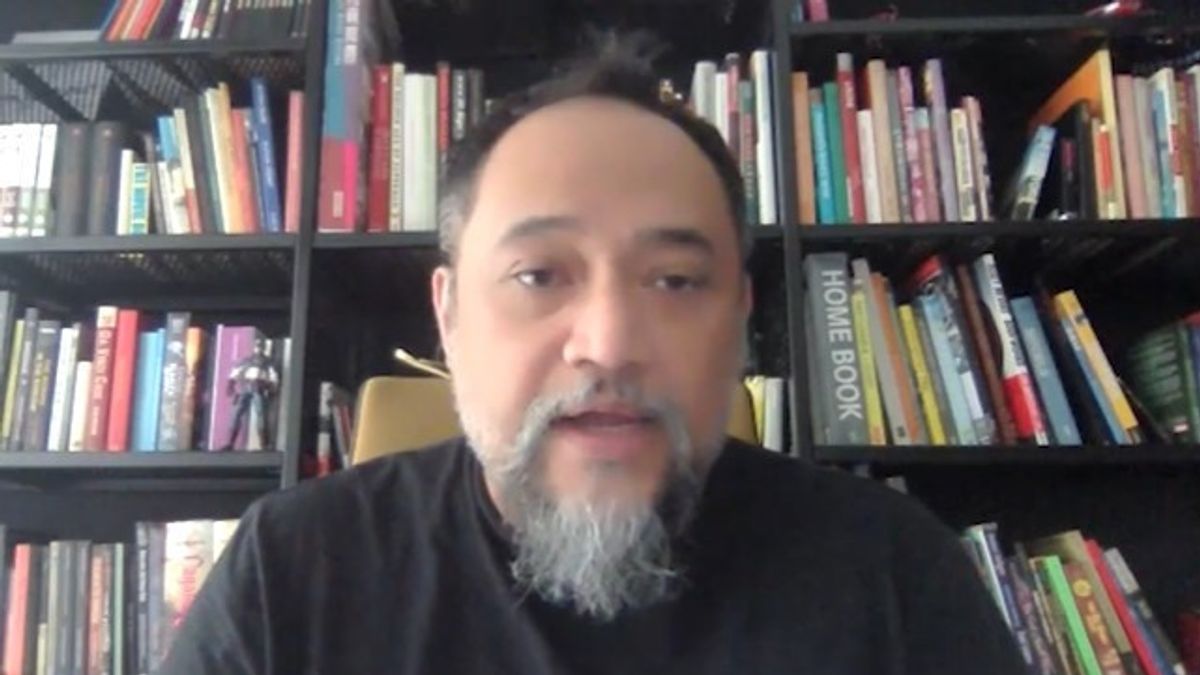JAKARTA - Music in a film is not just a complement to the origin of the sound. Music has a strategic role, in whatever film genre that wraps it. The emotions built in the film through music, will bring the audience's feelings deeper and more memorable.
Apart from that, music in films can actually be a geographic marker of which area the film's story comes from. This was said by Rako Prijanto, the director of films and scriptwriters, in a webinar entitled The Role of Music in Films held by the XIII Indonesian Journalists Film Festival Committee (FFWI) in Jakarta, Saturday 15 August.
Apart from Rako Prijanto as a resource person, Illustrator of Music as well as Director and Singer Tya Subiakto were also present, next to Irish Riswoyo and Retno Hermawati as moderators.
Rako Prijanto, who once directed the film Sang Kyai, said the music in the film was actually divided into two: namely scoring music which gives the rhythm of music as a background and original soundtrack.
Scoring and soundtrack are very effective in conveying what the film wants to feel. "So, music really helps every scene so that the story gets to the audience's feelings," said the 50-year-old director who once won the 2016 Maya Cup.
According to Rako theme song in a film can also be the character of the film. For example, if we suddenly hear a tone, we can immediately know that the tone is characteristic of the Indiana Jones, Superman or Star Wars film, for example.
"The point is that the music in the film's role is important, and cannot be separated in a story", said Rako.
On that occasion, Rako also explained that if in one production of thriller genre films, in it there is a scene depicting romance. So it can't be the color of the scoring music suddenly turns into romance. Indeed, there needs to be a romance color, but there must still be a thriller element, "explained Rako again.
At the end of his explanation, Rako said that the content of music or music scoring is aligned with the duration of the film. And most importantly, what is the need. "If there are too many. Moreover, the placement is not right, it will definitely disturb the feelings of the audience," he said.
Rako reminded that films are different from operas or oabarets that need a music background from front to back. "In films, sometimes there are certain parts that have to be muted. Otherwise, the audience's emotional graphs can even be too tired," he said.
另请阅读:
Mandatory Learning Music History Meanwhile, musician Tya Subiakto said someone who was appointed as a music arranger had an agreement on two people, namely producers and directors. Because they know the story's character, how the film's flow and conclusion is," said Tya, who once organized music for more than 60 film titles, including Paragraphs of Love, Habibi & Ainun, The Brightening and others.
If someone is interested in becoming a music arranger, said Tya, it should be equipped with other knowledge such as photography. In order to understand the point of view and language that is often used by the director.
In addition, it is also necessary to provide oneself with knowledge about film scenarios, although there is no need to go deep. Because in each scenario it consists of three rounds or eight sequences. From there we can arrange the music. For example, opening is not too high, or not luxurious," said Tya, who started her career through the film Sang Dewi (2007).
And one more thing, said Tya, a Music Illustrator must understand the history of music. For example, in working on the theme of the story in 1920, you have to understand at that time what music was developing. For example, jazz music must be sharpened again, what era is hits. Is Dixie or what? Don't get me wrong. It can be laughed at by viewers who know history! said Tya who won the Best Illustrator at the Bandung Film Festival through Paragraphs-Ayat Cita (2008) and Sang Pengangkali (2011).
Tya admits that she still often faces classic reasons about limited film production budgets, but producers want the film music to be worked on majestically using orchestra. And propose to use digital music orchestra.
According to Tya, that doesn't matter. As long as we master what kind of digital music orchestra is available. And I don't want to absorb it using just one keyboard, we still have to learn the principle of orchestra, that in the string section family, for example, there must be complete violence, violence, weakness, contra bass, said Tya, who admitted that the toughest challenge as an illustrator is the limited work time aka dateline.
In Tya's observations, if a person claims to have become a professional music arranger, he must be able to maintain professionalism by making his own music. Professional includes not taking other people's music and not using templates from other people's music!' said Tya.
The English, Chinese, Japanese, Arabic, and French versions are automatically generated by the AI. So there may still be inaccuracies in translating, please always see Indonesian as our main language. (system supported by DigitalSiber.id)


















